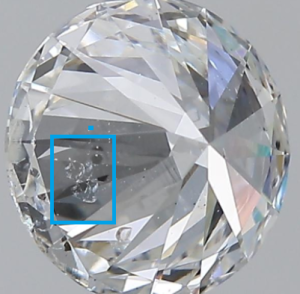Diversity in diamonds is part of their allure. These precious gemstones come with various intrinsic characteristics, which gemologists refer to as “inclusions.” Inclusions, which are naturally occurring features found within diamonds, contribute significantly to each stone’s unique identity. One intriguing type of inclusion that this article focuses on is known as a “cloud.”

Unraveling the “Cloud” Inclusion
Clouds in diamonds are clusters of minute inclusions, often too small to discern individually. These tiny inclusions, typically crystals or pinpoints, are spread over a larger area, giving the appearance of a soft, hazy, or cloudy region inside the diamond. Clouds can sometimes be challenging to see even under 10x magnification, which is the standard magnification used in diamond grading. This makes them among the most subtle of inclusions.
The Birth of “Cloud” Inclusions
Clouds are products of the diamond’s journey, born deep within the earth’s crust. They form when the diamond is still in its nascent stages, under immense pressure and temperature conditions. During the diamond’s creation, trapped minerals or irregularities in the crystal lattice can cluster together. Over time, these clusters manifest as clouds, effectively mapping out the diamond’s formative journey.
The Impact on Diamond’s Appearance
While clouds may sound like significant defects, their impact on a diamond’s appearance often remains minimal. Their effect on the diamond’s clarity grade largely depends on their size, number, position, and visibility. A few scattered clouds are generally not detrimental and may be nearly impossible to see with the naked eye. However, large or dense clouds can affect the stone’s transparency and brilliance, leading to a milky or hazy appearance.
Assessing Cloud Inclusions in Diamond Grading
In diamond grading, the presence of cloud inclusions and their effect on the diamond’s overall clarity is meticulously evaluated. Gemological laboratories, such as the GIA (Gemological Institute of America), use a scale to grade diamond clarity, ranging from Flawless (no inclusions or blemishes visible under 10x magnification) to Included (inclusions and/or blemishes visible to the naked eye). Diamonds with only minor cloud inclusions can still achieve high clarity grades.
The Value Aspect of “Cloud” Inclusions
When it comes to valuing diamonds, cloud inclusions can influence the cost, but not always negatively. Minor clouds that do not affect the stone’s overall brilliance may have little to no impact on its price. However, those clouds that affect the diamond’s transparency and brilliance could decrease its value. On the other hand, some buyers find cloud inclusions intriguing and value them for the unique identity they bestow upon the stone.
“Cloud” Inclusions: A Unique Tale to Tell
Every diamond has a story to tell, and inclusions are the narrators of these tales. Clouds, with their hazy, nebulous forms, evoke images of the diamond’s tumultuous journey from deep within the earth to the surface. They are a testament to the trials and tribulations that these stones have undergone during their creation, making them unique, much like fingerprints.
By delving into the world of diamond inclusions, particularly the enigmatic “clouds,” we can truly appreciate the intricate details that make each diamond unique. Clouds are not simply flaws; they are inherent parts of diamonds’ identities, telling fascinating stories of the stones’ incredible journeys from the depths of the earth to the sparkling adornments we cherish.